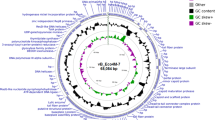Abstract
Escherichia coli O157:H7 is a human pathogen. We isolated a novel bacteriophage infecting this bacterium from a sewage water treatment facility. Phage PBECO4 belongs to the family Myoviridae, having an isometric head and a contractile tail. It has a linear double-stranded DNA genome of 348,113 base pairs in length with a GC content of 34.09 %. Whole-genome sequencing revealed that PBECO4 is distantly related to enterobacteria phage vB_KleM_RaK2, with 10 % similarity, and Cronobacter phage vB_CsaM_GAP32 with 6 % similarity. Five hundred fifty-one putative open reading frames (ORFs) and six tRNA genes were found. Eight ORFs are related to genes encoding structural proteins, nine to DNA packaging, two to DNA lysis activity, and 42 to replication and regulation. Four hundred ninety ORFs have not been functionally annotated.


Similar content being viewed by others
References
Wells JG, Shipman LD, Greene KD, Sowers EG, Green JH, Cameron DN et al (1991) Isolation of Escherichia coli serotype O157:H7 and other Shiga-like-toxin producing E. coli from dairy cattle. J Clin Microbiol 29:985–989
Hancock DD, Besser TE, Rice DH, Ebel ED, Herriott DE, Carpenter LV (1998) Multiple sources of Escherichia coli O157:H7 in feedlots and dairy farms in the Northwestern USA. Prev Vet Med 35:11–19
Chapman PA, Siddons CA, Wright DJ, Norman P, Fox J, Crick E (1993) Cattle as a possible source of verotoxin producing Escherichia coli O157 infections in man. Epidemiol Infect 111:439–447
Fincher LM, Parker CD, Chauret CP (2009) Occurrence and antibiotic resistance of Escherichia coli O157:H7 in a watershed in north-central Indiana. J Environ Qual 38:997–1004
Besser RE, Griffin PM, Slutsker L (1999) Escherichia coli O157:H7 gastroenteritis and the hemolytic uremic syndrome: an emerging infection. Annu Rev Med 50:355–367
Mohawk KL, Melton-Celsa AR, Zangari T, Carroll EE, O’Brien AD (2010) Pathogenesis of Escherichia coli O157:H7 strain 86–24 following oral infection of BALB/c mice with an intact commensal flora. Microb Pathog 48:131–142
Cimolai N, Carter JE, Morrison BJ, Anderson JD (1990) Risk factors for the progression of Escherichia coli O157:H7 enteritis to hemolytic-uremic syndrome. J Pediatr 116:589–592
Gerber A, Karch H, Allerberger F, Verweyen HM, Zimmerhack LB (2002) Clinical course and the role of Shiga toxin-producing Escherichia coli infections in the hemolytic-uremic syndrome in pediatric patients, 1997–2000, in Germany and Austria: a prospective study. J Infect Dis 186:493–500
Rangel JM, Sparling PH, Crowe C, Griffin P, Swerdlow DL (2005) Epidemiology of Escherichia coli O157:H7 outbreaks, United States, 1982–2002. Emerg Infect Dis 11:603–609
Obrig TG (1997) Shiga toxin mode of action in E. coli O157:H7 disease. Front Biosci 2:635–642
Chauret C (2011) Survival and control of Escherichia coli O157:H7 in foods, beverages, soil and water. Virulence 2:593–601
Goodridge LD, Bisha B (2011) Phage-based biocontrol strategies to reduce foodborne pathogens in foods. Bacteriophage 1:130–137
Kropinski AM, Mazzocco A, Waddell TE, Lingohr E, Johnson RP (2009) Enumeration of bacteriophages by double agar overlay plaque assay. Methods Mol Biol 501:69–76
Sambrook J, Russell DW (2006) Purification of bacteriophage lambda particles by centrifugation through a glycerol step gradient. CSH Protoc 2006(1). doi:10.1101/pdb.prot3969
Manfioletti G, Schneider C (1988) A new and fast method for preparing high quality lambda DNA suitable for sequencing. Nucleic Acids Res 16:2873–2884
Šimoliūnas E, Kaliniene L, Truncaite L, Klausa V, Zajančkauskaite A, Meškys R (2012) Genome of Klebsiella sp.-infecting bacteriophage vB_KleM_RaK2. J Virol 86:5406
Acknowledgements
This study was supported by HUFS research fund of 2013.
Author information
Authors and Affiliations
Corresponding author
Rights and permissions
About this article
Cite this article
Kim, M.S., Hong, S.S., Park, K. et al. Genomic analysis of bacteriophage PBECO4 infecting Escherichia coli O157:H7. Arch Virol 158, 2399–2403 (2013). https://doi.org/10.1007/s00705-013-1718-3
Received:
Accepted:
Published:
Issue Date:
DOI: https://doi.org/10.1007/s00705-013-1718-3




